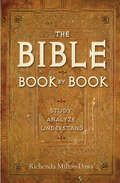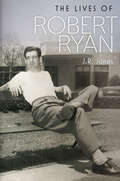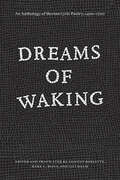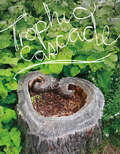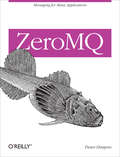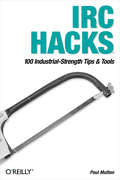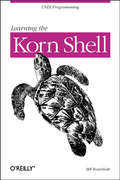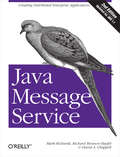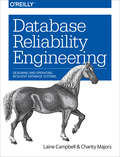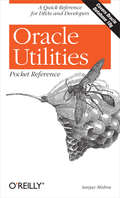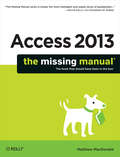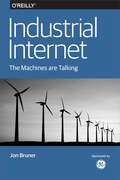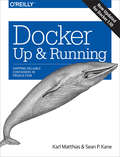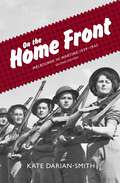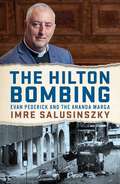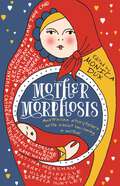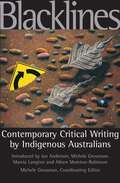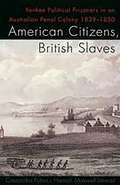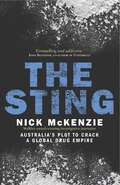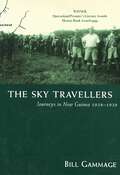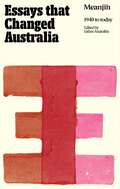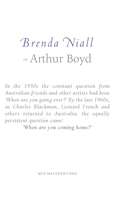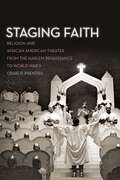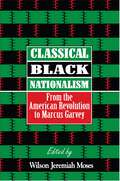- Table View
- List View
The Bible, Book by Book
by Richenda Milton-DawsAn essential reference guide for all Bible users—whether students or churchgoers—enabling anyone to get the most out of the Bible and its messages.Reading the bible has never been easier or through a more analytical eye. The Bible, Book by Book helps not only to read the bible, but encourages readers to knowledgeably understand and interpret the scriptures.The King James Holy Bible contains 39 books in the Old Testament, 27 books in the New Testament, and 14 books of the Apocrypha. This book presents each and every book of the Bible, with a short essential story synopsis, followed by a commentary for study and understanding. Finally, each book has a chapter by chapter summary in an easy to use table form.Biblical scripture offers many pearls of wisdom, and in this new reading, some of the most beautifully written books are analyzed in depth. Story, analysis, and commentary are covered on the events and lessons in each book to give readers the big picture.
The Lives of Robert Ryan (Wesleyan Film Ser.)
by J R JonesAn &“engrossing new biography&” of the actor famed for his menacing onscreen persona—and his offscreen work for peace and civil rights (Film Quarterly). The Lives of Robert Ryan is an in-depth look at the gifted, complex, intensely private man Martin Scorsese called &“one of the greatest actors in the history of American film.&” The son of a Chicago construction executive with strong ties to the Democratic machine, Ryan became a star after World War II on the strength of his menacing performance as an anti-Semitic murderer in the film noir Crossfire. Over the next quarter century, he created a gallery of brooding, neurotic, and violent characters in such movies as Bad Day at Black Rock, Billy Budd, The Dirty Dozen, and The Wild Bunch. His riveting performances expose the darkest impulses of the American psyche during the Cold War. At the same time, Ryan&’s marriage to a liberal Quaker and his own conscience launched him into a tireless career of peace and civil rights activism that stood in direct contrast to his screen persona. Drawing on unpublished writings and revealing interviews, film critic J.R. Jones deftly explores the many contradictory facets of Robert Ryan&’s public and private lives, and how these lives intertwined in one of the most compelling actors of a generation. &“Engaging . . . Jones describes a complex man who grappled publicly with the world&’s demons and privately with his own, among them alcohol and depression.&” —Associated Press &“Jones has done a superb job . . . A masterly biography.&” —Library Journal Includes photographs
Dreams of Waking: An Anthology of Iberian Lyric Poetry, 1400–1700
by Vincent Barletta, Mark L. Bajus, and Cici MalikIn this anthology, Vincent Barletta, Mark L. Bajus, and Cici Malik treat the Iberian lyric in the late Middle Ages and early modernity as a deeply multilingual, transnational genre that needs to break away from the old essentialist ideas about language, geography, and identity in order to be understood properly. More and more, scholars and students are recognizing the limitations of single-language, nationalist, and period-bound canons and are looking for different ways to approach the study of literature. The Iberian Peninsula is an excellent site for this approach, where the history and politics of the region, along with its creative literature, need to be read and studied together with the way the works were composed by poets and eventually consumed by readers. With a generous selection of more than one hundred poems from thirty-three poets, Dreams of Waking is unique in its coverage of the three main languages—Catalan, Portuguese, and Spanish—and lyrical styles employed by peninsular poets. It contains new translations of canonical poems but also translations of many poems that have never before been edited or translated. Brief headnotes provide essential details of the poets’ lives, and a general introduction by the volume editors shows how the poems and languages fruitfully intersect. With helpful annotations to the poetry, as well as a selected bibliography containing the most important editions and translations from all three of the main Iberian languages, this volume will be an indispensable tool for both specialists and students in comparative literature.
Trophic Cascade (Wesleyan Poetry Ser.)
by Camille T. Dungy&“A soulful reckoning for our twenty-first century, held in focus through echoes of the past and future, but always firmly rooted in now.&” —Yusef Komunyakaa, Pulitzer Prize-winning poet Winner of the Colorado Book Award in Poetry (2018) In this fourth book in a series of award-winning survival narratives, Dungy writes positioned at a fulcrum, bringing a new life into the world even as her elders are passing on. In a time of massive environmental degradation, violence and abuse of power, a world in which we all must survive, these poems resonate within and beyond the scope of the human realms, delicately balancing between conflicting loci of attention. Dwelling between vibrancy and its opposite, Dungy writes in a single poem about a mother, a daughter, Smokin&’ Joe Frazier, brittle stars, giant boulders, and a dead blue whale. These poems are written in the face of despair to hold an impossible love and a commitment to hope. A readers companion will be available at wesleyan.edu/wespress/readerscompanions. &“Dungy asks how we can survive despair and finds her answers close to the earth.&” —Diana Whitney, The Kenyon Review &“Trophic Cascade frequently bears witness—to violence, to loss, to environmental degradation—but for Dungy, witnessing entails hope.&” —Julie Swarstad Johnson, Harvard Review Online &“Tension. Simmering. Beneath her matter-of-fact, easy-going, sit-yourself-down, let-me-tell-it-like-it-is clarifying. And her power we take deadly seriously.&” —Matt Sutherland, Foreword Reviews &“[Trophic Cascade] asks us, in spite of the pain or difficulty of being human today, to find joy and vibrancy in our experiences.&” —Elizabeth Flock, PBS Newshour
ZeroMQ: Messaging for Many Applications
by Pieter HintjensDive into ØMQ (aka ZeroMQ), the smart socket library that gives you fast, easy, message-based concurrency for your applications. With this quick-paced guide, you’ll learn hands-on how to use this scalable, lightweight, and highly flexible networking tool for exchanging messages among clusters, the cloud, and other multi-system environments.ØMQ maintainer Pieter Hintjens takes you on a tour of real-world applications, using extended examples in C to help you work with ØMQ’s API, sockets, and patterns. Learn how to use specific ØMQ programming techniques, build multithreaded applications, and create your own messaging architectures. You’ll discover how ØMQ works with several programming languages and most operating systems—with little or no cost.Learn ØMQ’s main patterns: request-reply, publish-subscribe, and pipelineWork with ØMQ sockets and patterns by building several small applicationsExplore advanced uses of ØMQ’s request-reply pattern through working examplesBuild reliable request-reply patterns that keep working when code or hardware failsExtend ØMQ’s core pub-sub patterns for performance, reliability, state distribution, and monitoringLearn techniques for building a distributed architecture with ØMQDiscover what’s required to build a general-purpose framework for distributed applications
IRC Hacks: 100 Industrial-Strength Tips & Tools
by Paul MuttonIRC (Internet Relay Chat) may very well turn out to be the world's most successful hack. In 1988, Jarkko Oikarinen wrote the original IRC program at the University of Oulu, Finland. As he says in his foreword, "IRC started as one summer trainee's programming exercise. A hack grew into a software development project that hundreds of people participated in, and then became a worldwide environment where tens of thousands of people now spend time with each other. I have found many of my friends through IRC and learnt a significant part of my present software engineering knowledge while using and working with IRC. That would not have been possible without learning from code examples and hacks from others".IRC has continued to grow in popularity since its inception. Millions of people from all over the world now use IRC to chat with friends, discuss projects and collaborate on research. With a simple, clearly defined protocol, IRC has become one of the most accessible chat environments, with clients written for a multitude of operating systems. And IRC is more than just a simple chat system it is a network of intercommunicating servers, allowing thousands of clients to connect from anywhere in the world using the IRC protocol.While IRC is easy to get into and many people are happy to use it without being aware of what's happening under the hood, there are those who hunger for more knowledge, and this book is for them. IRC Hacks is a collection of tips and tools that cover just about everything needed to become a true IRC master, featuring contributions from some of the most renowned IRC hackers, many of whom collaborated on IRC, grouping together to form the channel #irchacks on the freenode IRC network (irc.freenode.net).Like all of our Hacks books, there are many different ways to use IRC Hacks. You can read the book from cover to cover, but you might be better served by picking an interesting item from the table of contents and just diving in.If you're relatively new to IRC, you should considering starting with a few hacks from each progressive chapter. Chapter 1 starts you off by showing you how to connect to IRC, while Chapter 2 acquaints you with the everyday concepts you'll need to use IRC effectively. Chapter 3 is all about users and channels, and introduces the first pieces of code. Chapter 4 shows you how to make useful enhancements to IRC clients.Chapter 5 is where you will learn the basics about creating IRC bots, with Chapters 6-12 introducing more complex bots that can be used for logging, servicing communities, searching, announcing, networking, managing channels or simply for having fun. Chapter 13 delves into the IRC protocol in more detail, and Chapter 14 demonstrates some interesting alternative methods for connecting to IRC. Finally, Chapter 15 will move you on to new pastures by showing you how to set up your own IRC server.This book presents an opportunity to learn how IRC works and how to make best use of some of the features that have made it the most successful, most scalable, and most mature chat system on this planet. IRC Hacks delves deep into the possibilities.
Learning the Korn Shell
by Bill RosenblattThis Nutshell Handbook® is a thorough introduction to the Korn shell, both as a user interface and as a programming language.The Korn shell, like the C and Bourne shells, is a program that interprets UNIX commands. It has many features that aren't found in other shells, including command history (the ability to recall and edit previous commands). The Korn shell is also faster; several of its features allow you to write programs that execute more quickly than their Bourne or C shell equivalents.This book provides a clear and concise explanation of the Korn shell's features. It explains ksh string operations, co-processes, signals and signal handling, and one of the worst "dark corners" of shell programming: command-line interpretation. It does this by introducing simple real-life examples and then adding options and complexity in later chapters, illustrating the way real-world script development generally proceeds. An additional (and unique) programming aid, a Korn shell debugger (kshdb), is also included.Learning the Korn Shell is an ideal resource for many UNIX users and programmers, including software developers who want to "prototype" their designs, system administrators who want to write tools for their own use, and even novices who just want to use some of ksh's more advanced interactive features.
Java Message Service: Creating Distributed Enterprise Applications
by Richard Monson-Haefel David A Chappell Mark RichardsJava Message Service, Second Edition, is a thorough introduction to the standard API that supports "messaging" -- the software-to-software exchange of crucial data among network computers. You'll learn how JMS can help you solve many architectural challenges, such as integrating dissimilar systems and applications, increasing scalability, eliminating system bottlenecks, supporting concurrent processing, and promoting flexibility and agility.Updated for JMS 1.1, this second edition also explains how this vendor-agnostic specification will help you write messaging-based applications using IBM's MQ, Progress Software's SonicMQ, ActiveMQ, and many other proprietary messaging services.With Java Message Service, you will:Build applications using point-to-point and publish-and-subscribe messaging modelsUse features such as transactions and durable subscriptions to make an application reliableImplement messaging within Enterprise JavaBeans (EJB) using message-driven beansUse JMS with RESTful applications and with the Spring application frameworkMessaging is a powerful paradigm that makes it easier to uncouple different parts of an enterprise application. Java Message Service, Second Edition, will quickly teach you how to use the key technology that lies behind it.
Database Reliability Engineering: Designing and Operating Resilient Database Systems
by Laine Campbell Charity MajorsThe infrastructure-as-code revolution in IT is also affecting database administration. With this practical book, developers, system administrators, and junior to mid-level DBAs will learn how the modern practice of site reliability engineering applies to the craft of database architecture and operations. Authors Laine Campbell and Charity Majors provide a framework for professionals looking to join the ranks of today’s database reliability engineers (DBRE).You’ll begin by exploring core operational concepts that DBREs need to master. Then you’ll examine a wide range of database persistence options, including how to implement key technologies to provide resilient, scalable, and performant data storage and retrieval. With a firm foundation in database reliability engineering, you’ll be ready to dive into the architecture and operations of any modern database.This book covers:Service-level requirements and risk managementBuilding and evolving an architecture for operational visibilityInfrastructure engineering and infrastructure managementHow to facilitate the release management processData storage, indexing, and replicationIdentifying datastore characteristics and best use casesDatastore architectural components and data-driven architectures
Oracle Utilities Pocket Reference: A Quick Reference for DBAs and Developers
by Sanjay MishraThe Oracle Utilities Pocket Reference is a handy, quick-reference guide to the multitude of Oracle utilities that database administrators (DBAs) use every hour of every day.As the undisputed leader among database products, Oracle is grasped conceptually by most DBAs. However, they understandably may not recall the specific utility to use for a given task, and, more commonly, won't in many cases remember the syntax to use. And that's exactly what the Oracle Utilities Pocket Reference supplies--the syntax and options for whatever utility a DBA needs to perform a given task.Some of the utilities documented in this guide include:SQL*Loader, for loading dataexpdp and exp for exporting data to another databaseoradebug for use in troubleshootingloadjava and dropjava for loading and unloading Java programsPacked with information in an easy-to-read format, this valuable resource is ideal for any experienced DBA. Even database programmers who deal with Oracle will truly appreciate having the Oracle Utilities Pocket Reference close at hand.Authored by Sanjay Mishra, a foremost authority on Oracle systems, this convenient and compact guide is focused and to-the-point, eliminating any potential guesswork or difficult memorization. The Oracle Utilities Pocket Reference is part of the strong-selling collection of O'Reilly "pocket reference" books.
Access 2013: The Missing Manual (The\missing Manual Ser.)
by Matthew MacDonaldUnlock the secrets of Access 2013 and discover how to use your data in creative ways. With this book’s easy step-by-step instructions, you’ll learn how to build and maintain a full-featured database and even turn it into a web app. You also get tips and practices from the pros for good database design—ideal whether you’re using Access for business, school, or at home.The important stuff you need to knowBuild a database with ease. Organize and update lists, documents, catalogs, and other types of information.Create your own web app. Let your whole team work on a database in the cloud.Share your database on a network. Link your Access database to SQL Server or SharePoint.Customize the interface. Make data entry a breeze by building your own templatesFind what you need fast. Search, sort, and summarize huge amounts of data in minutes.Put your info to use. Turn raw info into well-formatted printed reports.Dive into Access programming. Automate complex tasks and solve common challenges.
Industrial Internet
by Jon BrunerConsumer networks have revolutionized the way companies understand and reach their customers, making possible intricate measurement and accurate prediction at every step of every transaction. The same revolution is underway in our infrastructure, where new generations of sensor-laden power plants, cars and medical devices will generate vast quantities of data that could bring about improvements in quality, reliability and cost. Big machines will enter the modern era of big data, where they'll be subject to constant analysis and optimization. The promise of the industrial internet is that it will bring intelligence to industries that are capital-intensive and create broad value that all of the industrial internet's participants will share. This report examines the industrial internet across several industries. It describes both near-term efforts as well as the longer-term development that will emerge as software and machines further integrate.
Docker: Shipping Reliable Containers in Production
by Karl Matthias Sean P. KaneUpdated to cover Docker version 1.10 Docker is quickly changing the way that organizations are deploying software at scale. But understanding how Linux containers fit into your workflow—and getting the integration details right—are not trivial tasks. With this practical guide, you’ll learn how to use Docker to package your applications with all of their dependencies, and then test, ship, scale, and support your containers in production.Two Lead Site Reliability Engineers at New Relic share much of what they have learned from using Docker in production since shortly after its initial release. Their goal is to help you reap the benefits of this technology while avoiding the many setbacks they experienced.Learn how Docker simplifies dependency management and deployment workflow for your applicationsStart working with Docker images, containers, and command line toolsUse practical techniques to deploy and test Docker-based Linux containers in productionDebug containers by understanding their composition and internal processesDeploy production containers at scale inside your data center or cloud environmentExplore advanced Docker topics, including deployment tools, networking, orchestration, security, and configuration
LEO the Maker Prince: Journeys in 3D Printing
by Carla DianaLEO the Maker Prince teaches children (both young and old) about 3D printing by following Carla and LEO's journey through Brooklyn. LEO is a walking, talking robot who has the magical ability to to print (in plastic) any object that Carla draws. The other robots have their own special capabilities: H1-H0 prints in metal, Sinclair-10 can find and print objects from a huge catalog of designs, and the others (including AL1C3-D, IRIS-7, and NiXie) have unique talents, too. Readers can come along for the journey, too: all of the objects in the book are printable one way or another.
On the Home Front: Melbourne in Wartime: 1939—1945
by Kate Darian-SmithWhat really happened on the Australian home front during the Second World War?For the people of Melbourne these were years of social dislocation and increased government interference in all aspects of daily life. On the Home Front is the story of their work, leisure, relationships and their fears—for by 1942 the city was pitted with air raid trenches, and in the half-light of the brownout Melburnians awaited a Japanese invasion.As women left the home to replace men in factories and offices, the traditional roles of mothers and wives were challenged. The presence of thousands of American soldiers in Melbourne raised new questions about Australian nationalism and identity, and the 'carnival spirit' of many on the home front created anxiety about the issues of drunkenness, gambling and sexuality.Kate Darian-Smith's classic and evocative study of Melbourne in wartime draws upon the memories of men and women who lived through those turbulent years when society grappled with the tensions between a restrictive government and new opportunities for social and sexual freedoms.
Hilton Bombing: Evan Pederick and the Ananda Marga
by Imre SalusinszkyIn 1978, Evan Pederick, a naive 22-year-old in the thrall of a radical religious movement, Ananda Marga, placed an enormous bomb outside Sydney's Hilton Hotel. It killed three people. A decade later, Pederick confessed to this act of terrorism. But when one of his alleged accomplices was later acquitted, significant parts of Pederick's testimony were undermined and he was accused of being a 'fantasist'. Conspiracy theories flooded in to fill the vacuum. Was it a plot by ASIO, rather than, as Pederick asserted, a plot to assassinate the Indian prime minister? In the absence of a Royal Commission or similar inquiry, mystery continues to shroud the deadliest terror attack on Australian soil. Pederick, an Anglican priest, stands by his confession and testimony. Here is his story, told for the first time. It is an extraordinary tale of guilt, remorse, renewal, and the search for forgiveness.
Mothermorphosis: Australian storytellers write about becoming a mother
by Monica DuxThe mythology of motherhood is often reduced to clich�. But how do we articulate the complex internal conflicts, the exhilaration and the absurdity of this transformation? Mothermorphosis is a collection of essays on the experience as told by some of Australia's most talented writers and storytellers. In these stories we read about the yearning for a child, the private and public expressions of love, identity in the face of motherhood, gratitude, pride, celebration and loss. Ultimately we learn that there is no one version of this epic story, no one tale that could ever speak for all, and no one way of encapsulating the experience. However, in reading other women's experiences, the hard bits, the ridiculous bits, we can only become more compassionate, not just to other mothers but hopefully to ourselves.
Blacklines: Contemporary Critical Writings By Indigenous Australians
by Michele GrossmanWritten by established and emerging Indigenous intellectuals from a variety of positions, perspectives and places, these essays generate new ways of seeing and understanding Indigenous Australian history, culture, identity and knowledge in both national and global contexts. From museums to Mabo, anthropology to art, feminism to film, land rights to literature, the essays collected here offer provocative insights and compelling arguments around the historical and contemporary issues confronting Indigenous Australians today.
American Citizens, British Slaves
by Cassandra Pybus Hamish Maxwell-StewartWe hardly had our feet on the soil, when almost the first objects that greeted our vision were gibbets, and men toiling in the most abject misery, looking more degraded even than so many dumb beasts. Such sights, and the supposition that such might be our fate, served to sink the iron still deeper in our souls.This book tells the strange story of almost a hundred United States citizens who were transported to Van Diemen's Land in 1839-40.As members of the Patriot Army that had conducted border raids into the colony of Upper Canada in 1838, they saw themselves as courageous republican activists, impelled by a moral duty to liberate their northern neighbours from British oppression. Instead of heroic liberators, they became political prisoners of Her Majesty's government.Sent to Van Diemen's Land by Lieutenant-Governor Arthur—in the hope of deterring any more Yankees from exporting their abhorrent ideology to the Queen's domain—the Patriot exiles endured years of harsh treatment before they were eventually pardoned. Not being British subjects, their transportation was almost certainly illegal.Eleven of the Patriots wrote narratives about their time in Van Diemen's Land. From these interlocking accounts, Cassandra Pybus and Hamish Maxwell-Stewart have constructed a compelling story of the Patriots' experiences as convicts, drawing also on unpublished letters, newspaper reports and government archives.This vivid and intimate story of political exile and punishment provides a window into the everyday life of the many thousands of forgotten men and women who endured the calculated cruelties of penal transportation.Virtually unknown until brought to life in this remarkable book, the story of the Patriots also considers the political and legal issues of penal transportation as a tool of political repression.
Sting: Australia's Plot To Crack A Global Drug Empire
by Nick McKenzieIt was a David and Goliath style battle: Australian investigators up against a global organised crime empire. What seemed like an impossible task resulted in one of the most ambitious investigations in the world, infiltrating international money laundering streams and exposing the global crime bosses in control of the world's drug trade. The Sting is the never-before-told story of the ongoing efforts of Australia's most secretive and powerful law enforcement agency to topple the new face of organised crime. This is a tech-savvy, billion-dollar empire with tentacles reaching across the world, from outlaw motorcycle gangs to powerful Asian crime syndicates to law and government agencies. This is not a conventional story of good versus evil. It chronicles criminal, law enforcement and political tactics through the eyes of its major players - the criminal investigators, the international crime bosses, the senator, the drug cook and the investigative journalist - and exposes what many in power don't want the public to know.
Sky Travellers: Journeys in New Guinea 1938–1939
by Gammage, BillThe extraordinary story of the world's last major exploration and experience of first-contact-a 1938-39 Australian expedition of three thousand kilometres by foot, through the mountainous western highlands of Papua New Guinea. The pale skin of the strangers suggested that they were spirits-sky people. How should they be treated? Local people repeatedly asked 'Why have you come?' Jim Taylor, with John Black and Pat Walsh, led a patrol of over 350 people. Most were carriers from Highlands areas already familiar with Europeans; about 40 were new Guinea police from the coast. with war looming, records of their remarkable experience were officially suppressed. Bill Gammage has talked to many of the people who were there-both the visitors and those visited. With the rigour of a committed historian and a rare skill as a storyteller he traces a complex journey of minds as well as bodies. Every participant in this adventure was changed irrevocably. Readers, too, can expect an exhilarating mind shift.
Essays that Changed Australia: Meanjin 1940 to today
by Esther AnatolitisSince the 1940s, Meanjin essays have set the national cultural agenda. Arthur Phillips' idea of 'cultural cringe' has become a household word, instantly conveying Australians' sense of place in the world while expressing our frustrations and our ambitions - yet very few of us know it came from an essay first published in Meanjin. Over half a century later, Chelsea Watego's 2021 'Always bet on Black (power)' roars with the fire of a manifesto; Hilary Charlesworth's 1992 'A law of one's own?' challenges Australia's legal system with a formidable feminist ethic; Tim Rowse's 1978 'Heaven and a Hills Hoist' passionately defends suburbia; David Yencken's 1988 'Creative City' sparks a global urban planning movement with artists at the centre. This anthology brings togethers twenty impactful Meanjin essays for the first time. An introduction by editor Esther Anatolitis offers critical context and scrutiny, illustrating how profoundly Meanjin essays have changed Australia.
On Arthur Boyd
by Brenda NiallThe brilliant painter Arthur Boyd (1920-99) was a member of Australia's most famous artistic dynasty. This excerpt from Brenda Niall's prize-winning study, The Boyds , reveals Arthur Boyd as a man who lived in a private world of painting, family, friends and familiar surroundings, yet developed into an iconic Australian artist, celebrated at home and abroad.
Staging Faith: Religion and African American Theater from the Harlem Renaissance to World War II
by Craig R. PrentissIn the years between the Harlem Renaissance and World War II, African American playwrights gave birth to a vital black theater movement in the U.S. It was a movement overwhelmingly concerned with the role of religion in black identity. In a time of profound social transformation fueled by a massive migration from the rural south to the urban‑industrial centers of the north, scripts penned by dozens of black playwrights reflected cultural tensions, often rooted in class, that revealed competing conceptions of religion's role in the formation of racial identity.Black playwrights pointed in quite different ways toward approaches to church, scripture, belief, and ritual that they deemed beneficial to the advancement of the race. Their plays were important not only in mirroring theological reflection of the time, but in helping to shape African American thought about religion in black communities. The religious themes of these plays were in effect arguments about the place of religion in African American lives.In Staging Faith, Craig R. Prentiss illuminates the creative strategies playwrights used to grapple with religion. With a lively and engaging style, the volume brings long forgotten plays to life as it chronicles the cultural and religious fissures that marked early twentieth century African American society.Craig R. Prentiss is Professor of Religious Studies at Rockhurst University in Kansas City, Missouri. He is the editor of Religion and the Creation of Race and Ethnicity: An Introduction (New York University Press, 2003).
Classical Black Nationalism: From the American Revolution to Marcus Garvey
by Wilson Jeremiah MosesExamines the evolution of black nationalist thought from its earliest proto-nationalistic phase in the 1700s to the Garvey movement in the 1920sRecent years have seen a resurgence of interest in modern black nationalist leaders such as Stokely Carmichael and Malcolm X. But what of the ideological precursors to these modern leaders, the writers, and leaders from whose intellectual legacy modern black nationalism emerged? Wilson Jeramiah Moses, whom the Village Voice called one of the foremost historians of black nationalism, has here collected the most influential speeches, articles, and letters that inform the intellectual underpinnings of contemporary black nationalism, returning our focus to black nationalism at its inception. The goal of early black nationalists was the return of the African-American population to Africa to create a sovereign nation-state and to formulate an ideological basis for a concept of national culture. Most early black nationalists believed that this return was directed by the hand of God. Moses examines the evolution of black nationalist thought through several phases, from its proto-nationalisic phase in the late 1700s through a hiatus in the 1830s, through its flourishing in the 1850s, its eventual eclipse in the 1870s, and its resurgence in the Garvey movement of the 1920s.Moses provides us with documents that illustrate the motivations of both whites and blacks as they sought the removal of the black population. We hear from Thomas Jefferson, who held that it was self-evident that black and white populations could not intermingle on an equal basis or merge to form one happy society, and who toyed with the idea of a mass deportation of the black American population. We see that the profit motive is an important motive behind any nationalist movement in the letters between African American capitalists Paul Cuffe and James Forten. Among the more difficult selections to classify in this collection, Robert Alexander Young's Ethiopian Manifesto prophesied the coming of a prophetic liberator of the African race. The Christian nature of nineteenth century black nationalism is evident in Blyden's The Call of Providence.Moses rounds out the volume with contributions from more well- known voices such as those of Marcus Garvey, W.E.B. Dubois, and others. Classical Black Nationalism will serve as a point of departure for anyone interested in gaining a foundational knowledge of the disparate voices behind this often discussed but seldom understood movement.
